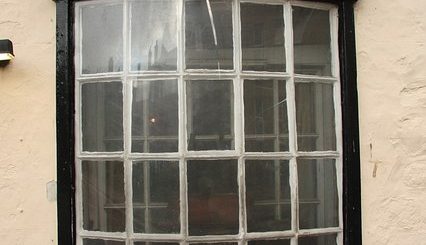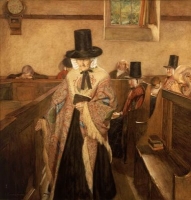The Devil’s Footprints
The mysterious footprints, which appeared overnight in heavy snowfall in Southern Devon in 1855, have never been adequately explained. According to contemporary reports, they stretched for over a hundred miles, and went through solid walls and haystacks, appearing on the other side as though there was no barrier. The extent of the footprints may have been exaggerated at the time, and they may have been the result of freak atmospheric conditions. But in truth the ‘footprints’, if that is what they were, still remain a complete mystery.
On the night of the 8th of February 1855, heavy snowfall blanketed the countryside and small villages of Southern Devon. The last snow is thought to have fallen around midnight, and between this time and around 6.00am the following morning, something (or some things) left a myriad of tracks in the snow, stretching for a hundred miles or more, from the River Exe, to Totnes on the River Dart.
 The early risers were the first to find them, strange hoof-shaped prints in straight lines, passing over rooftops, through walls and covering huge areas of land. A set of the prints were even supposed to have bridged a two mile span of the river Exe, continuing on the other side as if the creature had walked over the water.
The early risers were the first to find them, strange hoof-shaped prints in straight lines, passing over rooftops, through walls and covering huge areas of land. A set of the prints were even supposed to have bridged a two mile span of the river Exe, continuing on the other side as if the creature had walked over the water.
It soon became clear that the phenomenon was widespread, and some of the more scientifically minded examined the prints in detail. One naturalist sketched some of the marks, and measured the distance between them, it was found to be eight and a half inches. This spacing seemed to be consistant wherever the tracks were measured. It was also noted that the way in which they were set out, one in front of the other, suggested a biped rather than a creature walking on four legs.
Some clergymen suggested that the prints belonged to the Devil, who was roaming the countryside in search of sinners (a great ploy to fill the churches), while others rejected the idea as superstition. It is true that a feeling of unease had spread through some of the population, who watched carefully to see if the strange footprints would return. They did not and after a couple of days the news spread out of Devon and made the national press. The phenomena sparked correspondence in some of the leading papers including the Times and the Illustrated news. This brought more accounts to light, and led to a plethora of speculation by eminent scientists and lay men alike.
It seems that most of the Southern villages of Devon, from Totnes to Topsham, had been inundated with the prints in all manner of absurdities. Some stopped abruptly and continued after a large break, others stopped at walls as high as 14 feet, only to continue on the other side, leaving untouched snow on the top of the wall. Some were even said to have travelled through narrow apertures such as drainpipes.
The papers picked up that some kangaroos had escaped from a private Zoo belonging to a Mr Fische at Sidmouth, but the tracks description bears no resemblance to the tracks a kangaroo would leave. Sir Richard Owen, the eminent Biologist, suggested that the tracks were made by badgers, roaming the countryside in search of food. He explained the strange shape of the prints as the result of freeze-thaw action. This explanation only holds as much ground as the other theories given at the time, these included roaming racoons, rats, swans, otters and the theory that a hot air balloon passed over head trailing a rope. These could explain some of the tracks made that night, but certainly not all of them, unless all of the above were to blame in separate occurrences.
There are similar scattered cases from other parts of the world and also one written account in Britain. According to Ralph of Coggeshall, (who also recorded strange arial phenomena during his era) a writer from the 13th Century, on the 19th of July 1205 strange hoof print appeared after a violent electrical storm. In mid July these tracks would only be visible in the soft earth, and the electrical storm suggests some kind of natural phenomenon as yet unknown.
The Devil’s Footprints remain an intriguing mystery that will only truly be solved if the phenomenon happens again and can be examined more closely.




A similar but less known
A similar but less known episode involved the great explorer James Clark Ross.
One of the tasks of his historic 1839-1843 expedition was to take geomagnetic reading in a number of locations. One of these prearranged locations was the barren and desolate Kerguelen Island (now a French possession) in the Southern Indian ocean, which was reached in May 1840. While looking for a suitable location to set up their geomagnetic and astronomical stations the ship crew came across a trail of hoofprints in the snow, which was followed until it disappeared on the rocky soil. Ross wrote that he was "intrigued" by this discovery, since no creature native to the island could leave such prints. The HMSs Erebus and Terror stayed at Kerguelen for two months, while geomagnetic, tidal and astronomical observations were carried and both the officer and the crew explored the island in search of the mysterious beast but to no avail. One officer speculated that the hoofrints belonged to a horse which managed to swim to the shore from a wrecked ship, but his guess was as good as anybody else’s.
Devil’s Hoofprints
UFO looking for pubescent girls
The Measure-Marker was accidentally Left Idling, that time. Marker is like low power stone cutter and is seen as a cone shaped attachment on the ship.
It creates heat. This is the reason that the snow was removed and you could see the grass through the snow; instead of it being packed down.
When the hoofmarks appear in clusters, the ship is hovering and is wavering due to the drive inductor being out of sync with the earth’s gravity field, but the marker is still on.
The fact that the hoofprints were exactly 8 1/2 apart is due to the fact that the ship was in uniform motion and the Measurer-Marker reached out and made contact with the ground at regular invervals.
The marks were in a straight line. Nowhere in Mythology is there a one legged creature.
Tells the crew how far above the ground the ship is. Snowfall is a dead give-away that they are near.
The violent electrical storm is not natural; that’s their weapon. It means they are getting pissy with each other.
bluescarecrow – your
bluescarecrow – your conjecture that the markings indicated the presence of an extra-terrestrial spacecraft (which I assume is what you mean by UFO) is ambitious; having said that, it’s not the first time that strange markings on the ground have been attributed to UFO related phenomena. However, I don’t see any evidence to suggest that the mission of the UFO was to search for pubescent females!
Nowhere in Mythology is there a one legged creature
That’s a bit of an extreme comment- What about Hinkypunks? They hop on one leg in some folk tales. Or the Monopeds; a race of mythical people possessing one large foot that they sheltered from rain and hot sun under.
Or Huracan, the ‘one-legged’ god of wind and storm from Mayan mythos? I mean, that’s all I can recall off the top of my head, but that’s at three right off the bat.
One Legged
The Fachan was also supposed to hop around on one leg in the Glens of Scotland.
Interesting.
For my tuppence worth, I’d guess it was spirit phenomena. in this case, most likely a manifestation of the god Pan, or Cernunnos. [the Witches’ Horned God.]
Some demons also may manifest in Goat-footed, or cloven hooved, or hooved forms, but much fewer of them than you might think. It’s also very possible that the entity making these things was invisible, so nobody saw anything. It’s hard for entities to appear to human eyes, although they can have a strong enough prescence to influence or impress upon malleable media such as snow.
With, I’m sure you know, the great amount of paganism, witchcraft and magical practices that have always been practiced in the South West areas, it’s feasible, I think, that somebody was doing rituals, and manifested an entity of some atavistic kind such as may leave these prints. I must add that it won’t be the only time such a thing has happened, but it may be one of the only times we got left evidence of these physical phenomena, of course with the snow showing up the prints! If it happened in summer, lets face it the prints would be much fewer, in some soft soil here and there perhaps. Nobody would take much notice!
I thought of the Fachan too,
I thought of the Fachan too, Peg Keg Jack, or Spring HeelJack, too. But if we begin to dwell on the possibility of it being a one-legged creeature from mythology or legend, we could also consider that it might have been a guy jumping on one leg?
But really, none of that explains the length of the trail, or its ability to go through solid walls.
Re: The Devil’s Footprints
I wouldn’t think anyone participating in a ritual over 100 years ago would have travelled the distance of 100 miles in one night before the snow had thawed or the tracks being covered !
This one is a mystery, I could only assume that the event was exaggerated or the local clergy was using propaganda to scare people to church, maybe the congregation at the time was lacking ?
Anyway if it were the devil why would it be wearing shoes? One of the details at in the report was that the prints looked like Donkey Shoes, Only Horses and Donkeys destined for road work wear shoes… The Devil wouldn’t need to.
Re: The Devil’s Footprints
This was one of the first unexplained phenomena that I read about as a child.I still find it unnerving.I have no idea as to what is/was capable of running over such a distance and at such heights(as a logical explanation). I have however always thought of Spring heeled jack as being the culprit. Who knows? Good mystery though!
Re: The Devil’s Footprints
Mike Dash examined contemporary sources and published his findings in the first number of Fortean Studies, concluding that the case seems to have been blown out of proportion, possibly by sensation-seeking newspapers.
In particular he points out that there appear to have been multiple trails of varying length, indicating multiple causes. The most sensational reports, like tracks leading into a haystack and reappering on the opposite side, appear to be anonymous and secondhand.
Additionally eyewitnesses spoke clearly of claw marks or rounded prints.
According to some researchers the story was willingly blown out of proportion by a London newspaper to make fun of the "rural Devonians", who were pictured as a credulous and superstitious lot.
It should be noted that a similar hoofmark trail was found on the Devon coast in October 1950 but the case didn’t spark as much interest as the original article.
Re: The Devil’s Footprints
I find all this really fascinating.Could it be some type of alien?
Re: Devil’s Hoofprints
Hello bluescarecrow. You are, of course, right….but I do not know you. Alias?